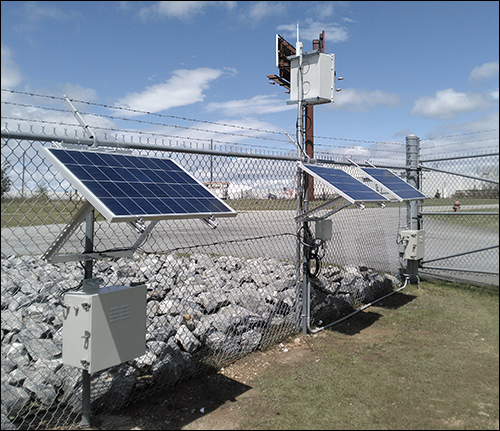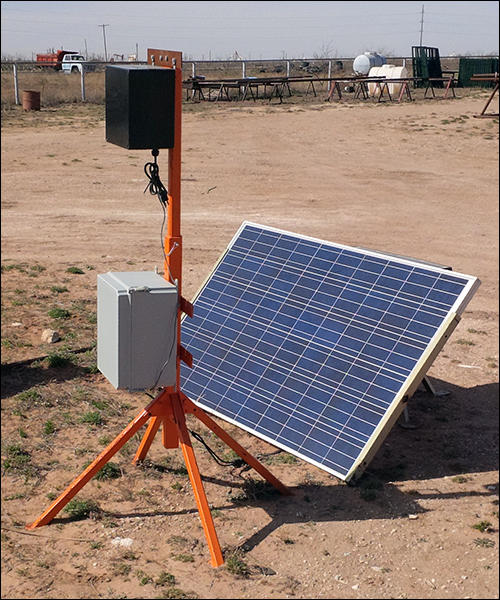Several companies are piloting or deploying a solar-powered real-time location system (RTLS) from Canadian technology company GuardRFID Solutions that is intended to deliver low-cost location data regarding people and things in places that do not lend themselves to technology. The AllGuard Real-time Location Platform system allows active RFID RTLS technology to be quickly and easily deployed at locations that lack power sources or network connectivity, says Zahir Abji, GuardRFID’s president and CEO, or that cannot accommodate cabling and permanent installations.
The system consists of wireless 433 MHz RFID Solar Powered Tag Readers (SPTRs) that can be mounted on existing structures or be placed in strategic locations on a tripod. They come with a solar panel measuring 24 inches by 36 inches to power the readers, which collect data and use a Wi-Fi connection to send read data to a hub installed at the facility and then back to GuardRFID’s cloud-based server, via cellular or satellite connectivity. The Application Client middleware (businesses can use their own software if they prefer) then interprets the location data and pushes that information to the company’s own software. If no connectivity is available, the readers store the data until it can be accessed.
The system also comes with Solar Powered Tag Exciters (SPTEs) to provide greater location granularity. Each GuardRFID exciter serves to awaken a tag via its 125 KHz transmission, prompting the tag’s response. The solar-powered readers then capture each tag’s ID number with the exciter identification, and GuardRFID software approximates the tag’s location to within a few meters.
In this way, Abji says, companies can create a variety of solutions at a relatively low cost. GuardRFID’s partners are deploying the technology with multiple companies, which have asked to remain unnamed. Users can track such items as vehicles moving around yards, as well as other equipment, assets and personnel in places where permanent RTLS infrastructure isn’t feasible.
One common use case is worker safety in the oil and gas industry. Simply deploying a passive RFID system with zones and gates typically requires fixed infrastructure to read ID badges as they pass through portals. Alternatively, companies must use handheld readers to interrogate tags on badges when staff members enter or leave an area during emergency mustering. This does not provide real-time location data, however, and can require the cost of the wired readers or the labor associated with employees reading badges.
With the GuardRFID system, companies place the readers around an area, as well as exciters at specific locations within a span of one-half to 10 meters (1.6 to 32.8 feet). In an open space, the SPTRs can read GuardRFID tags at a distances of 400 meters (1,312 feet). In heavy industrial environments, such as robotized car assembly plants, read distances of 50 to 100 meters (164 to 328 feet) are more common.

Companies can pinpoint an employee’s location at a work site, as well as identify when that individual has entered an unauthorized zone, or where he or she is in the event of an evacuation. Readers and exciters are also placed at muster locations to automatically detect personnel who have made it to these sites.
In addition, the GuardRFID 433 MHz ST-3 tag comes with distress buttons that an individual wearing that tag can press if he or she requires support. That alert, along with the RTLS data about the location, can enable GuardRFID software to identify where that individual is located, so that personnel can be dispatched to that location to provide assistance. An acknowledgement can also be transmitted to the tag to inform the user that the signal has been received.
In another use case, the technology can be used to track assets at such locations as laydown yards or construction sites. In this scenario, a company can not only identify in real time where its assets—such as high-value equipment—are located as they are stored in or moved throughout a yard, buy also receive alerts. A user attaches an active GuardRFID tag to an asset. The tag can be programmed to transmit only when it is in motion, or when it is being excited by the SPTE, in order to preserve battery life. Alerts can identify when an asset is moving, or if it has left its expected zone. Additionally, the software enables users to set a window of time during which an item should not move (such as outside of business hours).
According to the company, the technology not only reduces labor hours that workers would otherwise spend searching for assets, but can also prevent loss before it occurs. For instance, Abji says, in one case a company was able to detect when a large piece of equipment valued at $440,000 was being removed from the site, based on the exciter and reader data collected as the tagged item approached the exit. The company was then able to prevent that equipment’s removal.
At manufacturing facilities, the system provides RTLS functionality in large areas in which products are being assembled. The read data as the products move through assembly or onto a finished goods storage yard enables the manufacturer to better manage its work-in-progress.
“This provides companies with a beginning-to-end view into their production cycle,” Abji says. The company can also equip a customer’s management or staff with a GuardRFID mobile app, he adds, on which they can gain location data while moving around a facility in a forklift or on foot.
Both the SPTR and SPTE can operate for up to five days without exposure to sunlight or daylight, Abji says, before they would need to be recharged. The AllGuard Real-time Location Platform system is commercially available now, and is being deployed by GuardRFID’s partners.



